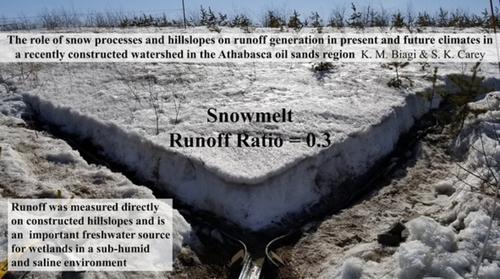当前位置:
X-MOL 学术
›
Hydrol. Process.
›
论文详情
Our official English website, www.x-mol.net, welcomes your
feedback! (Note: you will need to create a separate account there.)
The role of snow processes and hillslopes on runoff generation in present and future climates in a recently constructed watershed in the Athabasca oil sands region
Hydrological Processes ( IF 2.8 ) Pub Date : 2020-06-22 , DOI: 10.1002/hyp.13836 Kelly M. Biagi 1 , Sean K. Carey 1
Hydrological Processes ( IF 2.8 ) Pub Date : 2020-06-22 , DOI: 10.1002/hyp.13836 Kelly M. Biagi 1 , Sean K. Carey 1
Affiliation

|
Mine reclamation in the Athabasca oil sands region Canada, is required by law where companies must reconstruct disturbed landscapes into functioning ecosystems such as forests, wetlands, and lakes that existed in the Boreal landscape prior to mining. Winter is a major hydrological factor in this region as snow covers the landscape for 5–6 months and is ~25% of the annual precipitation, yet few studies have explored the influence of winter processes on the hydrology of constructed watersheds. One year (2017–2018) of intensive snow hydrology measurements are supplemented with 6 years (2013–2018) of meteorological measurements from the constructed Sandhill Fen watershed to: (a) understand snow accumulation and redistribution, snowmelt timing, rate, and partitioning, (b) apply a physically based model for simulating winter processes on hillslopes, and (c) evaluate the impact of soil prescriptions and climate change projections on winter processes in reclaimed systems. The 2017–2018 snow season was between November and April and snow water equivalent (SWE) ranged between 40 and 140 mm. Snow distribution was primarily influenced by topography with little influence of snow trapping from developing vegetation. Snow accumulation was most variable on hillslopes and redistribution was driven by slope position, with SWE greatest at the base of slopes and decreased toward crests. Snowmelt on hillslopes was controlled by slope aspect, as snow declined rapidly on west and south‐facing slopes, compared with east and north‐facing slopes. Unlike results previously reported on constructed uplands, snowmelt runoff from uplands was much less (~30%), highlighting the influence of different construction materials. Model simulations indicate that antecedent soil moisture and soil temperature have a large influence on partitioning snowmelt over a range of observed conditions. Under a warmer and wetter climate, average annual peak SWE, and snow season duration could decline up to 52% and up to 61 days, respectively, while snowmelt runoff ceases completely under the warmest scenarios. Results suggest considerable future variability in snowmelt runoff from hillslopes, yet soil properties can be used to enhance vertical or lateral flows.
中文翻译:

在阿萨巴斯卡油砂地区最近建造的流域中,雪过程和山坡在当前和未来气候中对径流产生的作用
根据法律规定,加拿大阿萨巴斯卡油砂地区的矿山开垦是必须的,公司必须在开采之前将受干扰的景观重建为正常的生态系统,例如北方景观中存在的森林,湿地和湖泊。冬季是该地区的主要水文因素,因为雪覆盖了5-6个月的地形,约占年降水量的25%,但很少有研究探讨冬季过程对人工流域水文学的影响。一年(2017-2018年)的密集雪水文测量结果,再加上6年(2013-2018年)的人工构建沙丘芬分水岭的气象测量结果,以:(a)了解积雪和再分布,融雪时间,速率和分区, (b)应用基于物理的模型来模拟山坡上的冬季过程,(c)评价开垦系统中土壤配方和气候变化预测对冬季过程的影响。2017-2018年的雪季在11月至4月之间,雪水当量(SWE)介于40至140毫米之间。积雪的分布主要受地形影响,而生长中的植被对积雪的影响很小。在山坡上积雪变化最大,并且重新分布受斜坡位置驱动,SWE在斜坡底部最大,而向山顶下降。山坡上的融雪受坡度的控制,西坡和南坡与东坡和北坡相比降雪迅速。与先前报道的人工高地的结果不同,来自高地的融雪径流要少得多(约30%),强调不同建筑材料的影响。模型模拟表明,在一定的观测条件下,前期土壤水分和土壤温度对融雪的分配有很大影响。在气候变暖和潮湿的情况下,平均年度最高水温和降雪持续时间可能分别下降多达52%和61天,而融雪径流在最温暖的情况下将完全停止。结果表明,未来山坡融雪径流的变化很大,但土壤性质可用于增加垂直或横向流动。在最温暖的情况下,融雪径流将完全停止,而雪季持续时间可能分别下降52%和61天。结果表明,未来山坡融雪径流的变化很大,但土壤性质可用于增加垂直或横向流动。在最温暖的情况下,融雪径流将完全停止,而雪季持续时间可能分别下降52%和61天。结果表明,未来山坡融雪径流的变化很大,但土壤性质可用于增加垂直或横向流动。
更新日期:2020-06-22
中文翻译:

在阿萨巴斯卡油砂地区最近建造的流域中,雪过程和山坡在当前和未来气候中对径流产生的作用
根据法律规定,加拿大阿萨巴斯卡油砂地区的矿山开垦是必须的,公司必须在开采之前将受干扰的景观重建为正常的生态系统,例如北方景观中存在的森林,湿地和湖泊。冬季是该地区的主要水文因素,因为雪覆盖了5-6个月的地形,约占年降水量的25%,但很少有研究探讨冬季过程对人工流域水文学的影响。一年(2017-2018年)的密集雪水文测量结果,再加上6年(2013-2018年)的人工构建沙丘芬分水岭的气象测量结果,以:(a)了解积雪和再分布,融雪时间,速率和分区, (b)应用基于物理的模型来模拟山坡上的冬季过程,(c)评价开垦系统中土壤配方和气候变化预测对冬季过程的影响。2017-2018年的雪季在11月至4月之间,雪水当量(SWE)介于40至140毫米之间。积雪的分布主要受地形影响,而生长中的植被对积雪的影响很小。在山坡上积雪变化最大,并且重新分布受斜坡位置驱动,SWE在斜坡底部最大,而向山顶下降。山坡上的融雪受坡度的控制,西坡和南坡与东坡和北坡相比降雪迅速。与先前报道的人工高地的结果不同,来自高地的融雪径流要少得多(约30%),强调不同建筑材料的影响。模型模拟表明,在一定的观测条件下,前期土壤水分和土壤温度对融雪的分配有很大影响。在气候变暖和潮湿的情况下,平均年度最高水温和降雪持续时间可能分别下降多达52%和61天,而融雪径流在最温暖的情况下将完全停止。结果表明,未来山坡融雪径流的变化很大,但土壤性质可用于增加垂直或横向流动。在最温暖的情况下,融雪径流将完全停止,而雪季持续时间可能分别下降52%和61天。结果表明,未来山坡融雪径流的变化很大,但土壤性质可用于增加垂直或横向流动。在最温暖的情况下,融雪径流将完全停止,而雪季持续时间可能分别下降52%和61天。结果表明,未来山坡融雪径流的变化很大,但土壤性质可用于增加垂直或横向流动。











































 京公网安备 11010802027423号
京公网安备 11010802027423号